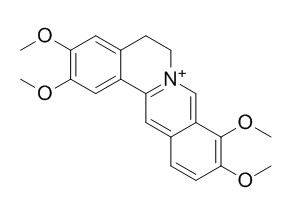Natural Products
Palmatine
| Catalog No. | CFN98459 |  |
| CAS No. | 3486-67-7 | |
| Molecular Weight: | 352.4 | |
| Molecular Formula | C21H22NO4 | |
| DBs | [PubChem]:274951362 [ChEMBL]:16096 [PCIDB]:1898 |
Standard InChI:
InChI=1S/C21H22NO4/c1-23-18-6-5-13-9-17-15-11-20(25-3)19(24-2)10-14(15)7-8-22(17)12-16(13)21(18)26-4/h5-6,9-12H,7-8H2,1-4H3/q+1
Biological Activity
Palmatine , a protoberberine alkaloid, is present in preparations from medicinal plants such as Coptis chinensis and Corydalis yanhusuo, palmatine activates the AhR-CYP1A pathway in HepG2 monolayer, while the potential for CYP1A induction is irrelevant in cell systems which are closer to the in vivo situation, i.e. in HepG2 spheroids and primary cultures of human hepatocytes. [1]
Palmatine exerts protective effect on hepatocytes, the inhibitory effects on I(K) and I(CRAC) could be one of the mechanisms.[2]
The alkaloids berberine, palmatine and sanguinarine are toxic to insects and vertebrates and inhibit the multiplication of bacteria, fungi and viruses; berberine and palmatine were most active at the alpha 2-receptor (binding with IC50 476 and 956 nM, respectively). [3]
Palmatine at a low concentration (50 μg/mL) begins to inhibit the growth of T. thermophila BF5, and when the concentration of palmatine reached 600 μg/mL, T. thermophila BF5 could not grow at all, shows the strong toxic action of palmatine on T. thermophila BF5 growth. [4]
Product
References
[1] Vrba J, Havlikova M, Gerhardova D, et al. Toxicol Vitro, 2014, 28(4):693-9.
[2] Fang W, Zhou H Y, Lan C, et al. World J Gastroentero, 2003, 9(2):329-33.
[3] Schmeller T, Latz-Brüning B, Wink M. Phytochemistry, 1997, 44(2):257-266(10).
[4] Kong W J, Zhao Y L, Xiao X H, et al. J Hazard Mater, 2009, 168(168):609-13.
[5] Huang J, Weng W, Cao D, et al. Chromatographia, 2005, 62(62):471-74.
Product Use Citation





